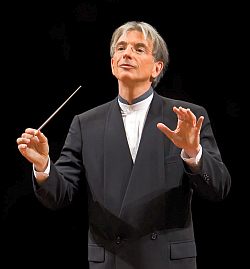
Featured Video
Related Article
Gustav Mahler Biography
Listen to music by Gustav Mahler
San Francisco Symphony’s Mahler Series Shimmers to a Close
Mahler: Songs With Orchestra
Set afloat by the San Francisco Symphony, the famous Adagietto of Mahler’s Fifth Symphony seems freshly conjured as the violin section floats dreamily by onscreen. Moments later, when Music Director Michael Tilson Thomas compares the “stop-and-start” quality of the Mahler Seventh to jump-cutting in a film, shots of the string players’ harsh snap pizzicatos are tersely intercut with leering scenes from director F. W. Murnau’s 1926 Faust film.
Fans of the San Francisco Symphony’s celebrated Keeping Score television series are accustomed to such adroit pairings of sight and sound. Since their debut in 2006, the PBS-broadcast programs have reshaped the public perception of classical music documentaries. Entertaining, substantive, often moving and instructive without a trace of pedantry, the hour-long shows have opened new doors of appreciation and understanding, for novices and veteran concertgoers alike, into the music of Beethoven, Berlioz, Copland, and others.
With a pair of linked programs on Mahler that premiere this month, Keeping Score reaches a lofty new peak of documentary achievement and technical aplomb. Gustav Mahler: Origins, premiering April 14 at 9 p.m. on KQED, focuses largely on the composer’s First Symphony, exploring the work’s distinctive musical and personal roots as well as the historical groundwater that fed it. Gustav Mahler: Legacy (April 21 at 9 p.m.) sweeps through a wider swath of music even as it deepens this intimate two-hour portrait of an artist.
Finding the Emotional Hook: Connecting Mahler to a Place
Mahler was an inevitable destination for Keeping Score and Tilson Thomas, the series host and guiding spirit. Timed for release in a year that marks the centennials of both Mahler’s death and the San Francisco Symphony’s founding in 1911, the Origins and Legacy programs affirm a deep connection between the composer and this ensemble. Mahler is “the central musical figure of my life,” MTT remarks near the end of the second segment. That will come as no surprise to those who have followed the Symphony’s impassioned and penetrating performances of the composer’s canon, live and recorded, over the past decade. Tilson Thomas’ visits to Mahler’s Bohemian hometown of Iglau, his lakeside home in the Alps, to a nearby composing hut, and to other locations in these programs have the urgency and quiet intensity of a pilgrimage.
Essential as MTT is to the triumph of the Mahler Keeping Score project, the shows depend just as much for their success on their overall conception, direction, and technical execution. From the frictionless camerawork that captures the San Francisco Symphony in performance at Davies Symphony Hall to a sustained and multilayered montage that conveys the sublimity and heartbreaking anguish of the Ninth Symphony, the two programs fuse content and form in masterly new ways.
Keeping Score coproducer and director David Kennard comes at the project with a wide-lens perspective. “There’s a huge parallel between a symphony and a documentary,” he says. “In both cases you want to be stimulated and satisfied at the end.”
Determined to avoid the “terrible, Tubby-the-Tuba legacy of avuncular, patronizing musical education,” Kennard and his coproducer and director Joan Saffa pointedly move beyond concert hall lectures and musical examples to “tell real stories about real people and real places that connect with the audience on an emotional level.” The method and impact of the music are gracefully interwoven with the composer’s life and psychology, as well as the era and epoch in which he lived. “What we’re trying to do is speak to the head and the heart at the same time.”
In the case of Mahler, shooting on location yielded an important revelation. It was only when Tilson Thomas was actually walking the streets of Iglau (now Jihlava) that he realized how the layout of Mahler’s hometown mirrored the musical sources he tapped so directly in his symphonies and song cycles. That sense of excited discovery comes across clearly on screen, as MTT spins around to point out the tavern, synagogue, church, school, and military parade ground where Mahler would have taken in the rich “sonic goulash” of his formative years.
Another site-specific adventure occurred when Kennard, Saffa, and company set out to find a military band and a location to shoot them. With the help of researchers and a stroke of pure luck, the producers discovered an abandoned Austrian barracks that was about to be made over into condominiums. The shoot took place, in this small window of opportunity, with rain clouds looming. It’s an evocative highlight of the programs.
Camera Operators, Robots — and a Lot of Planning

Everything comes back to the music, finally. That’s where the technical wizardry of Keeping Score takes over. By deploying as many as 13 different cameras, some of them robotic, director Gary Halvorson and his Davies Hall team create a fluent visual language of tracking shots, pans, wipes, and flyovers. Thanks to what San Francisco Symphony General Manager John Kieser calls “a ballet of camerawork,” the viewer often has the visceral sense of entering the performance space. Revealing closeups are part of it, as an oboist’s cheeks tense and pucker or a harp string vibrates almost violently. But it’s when the shots start to move, sometimes suavely, sometimes with minutely timed cuts and jolts, that the dynamic nature of symphonic music is made dramatically visible.
First developed for sporting events, the compact robotic cameras can venture where no fixed lens can. Several of them ride tracks along the front of the orchestra or snaking through the musicians. Another robotic camera is mounted on a 22-foot tower at the back of the stage. “They are very humanlike,” says Kieser, “in how they can pan, tilt, and zoom. They occupy a smaller footprint and can make very smooth transitions.” But Kieser also reserves praise for the manned cameras, which can handle some flyover shots more effectively. “The technology is not there yet for the robotics to do everything.”
Armed with a marked copy of the score, a shot list that might number over a thousand in a Mahler symphony, and a precise plot of where all the musicians will be seated, the producer, director, and camera crew get a rehearsal, without the orchestra present, the day before the shoot. A musical “dress rehearsal” follows. Scratch tapes of both serve as visual rough drafts.
Mission control is in a truck parked on the Franklin Street side of Davies Hall. A director, an assistant director, and a switcher coordinate the hair-trigger cuts from one shot to another. The music is recorded elsewhere, in the Davies booth. A second taping helps cover any fumbles or audience noise. The trouble is worth it, argues Kieser. “Recording in front of an audience brings a level of excitement and spontaneity you can never get in a studio setting.”
The viewer never feels overwhelmed by all this visual control. Everything is folded seamlessly into the narrative and emotional pull of Mahler’s musical narrative. In the brilliant climax of the Legacy chapter, images from nature, pages of a score, archival photographs, MTT’s exegesis of a “turn” motif in the Ninth Symphony, and passages of that great work itself overlap, blend, and enrich each other. It’s a full-body immersion of thought and feeling, imagery and memory, music and ineffable meaning.
“When you make a documentary it’s all about being surprised,” Tilson Thomas says. That’s what happened to him when he walked the streets of Mahler’s hometown. And it’s what happens to us when we come along with MTT, seeing and sensing and hearing what he did on this vibrant and sustaining Mahler quest.

